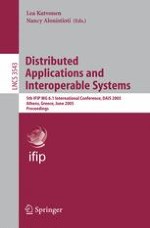2005 | Buch
Distributed Applications and Interoperable Systems
5th IFIP WG 6.1 International Conference, DAIS 2005, Athens, Greece, June 15-17, 2005. Proceedings
herausgegeben von: Lea Kutvonen, Nancy Alonistioti
Verlag: Springer Berlin Heidelberg
Buchreihe : Lecture Notes in Computer Science
